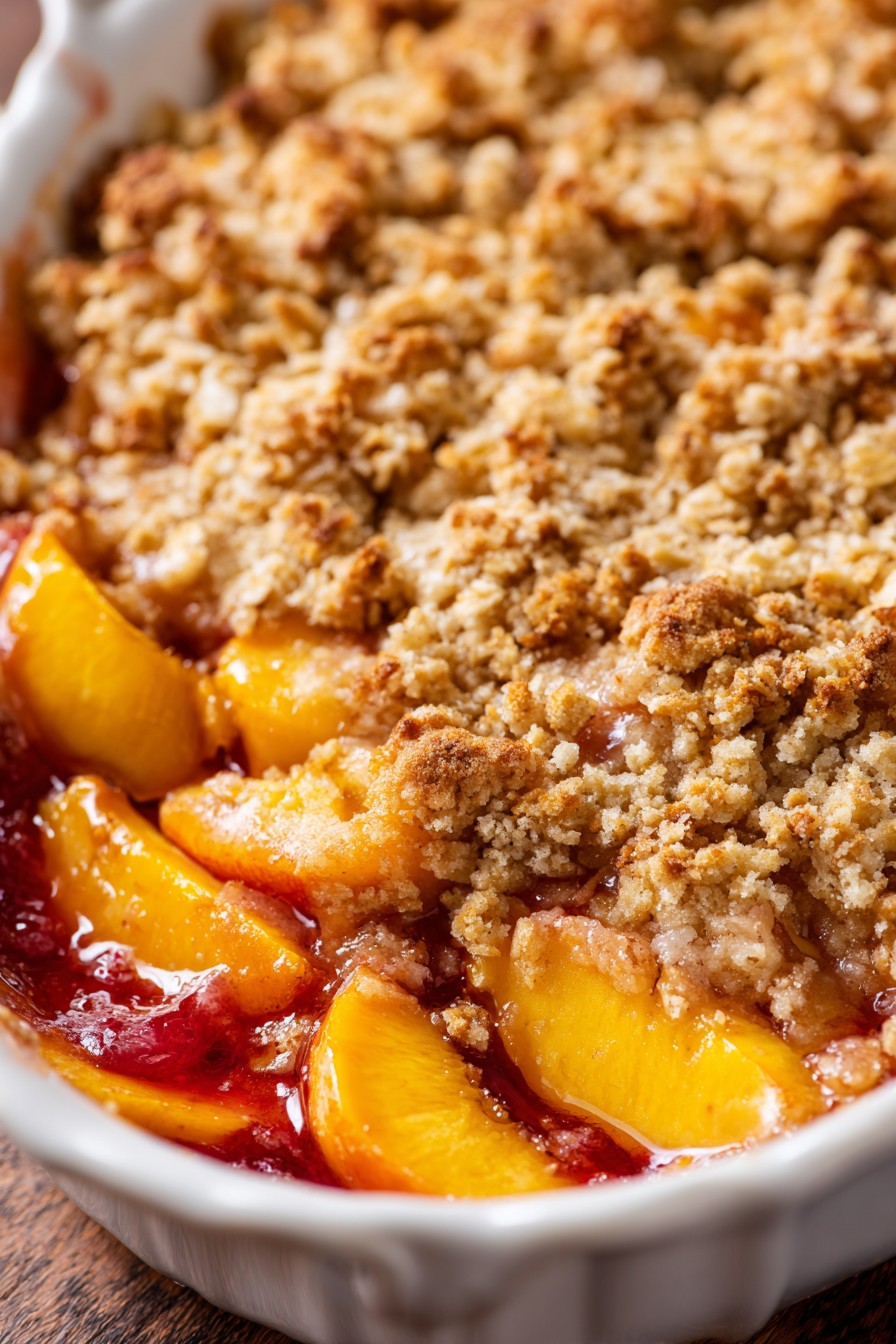Creating this peach cobbler dump cake couldn’t be simpler while delivering incredible flavor and nutritional benefits. Combining juicy peaches with wholesome ingredients creates a dessert that satisfies sweet cravings while providing valuable nutrients. This approachable recipe transforms basic pantry staples into a comforting treat perfect for family gatherings or weeknight desserts.
Why This Recipe Works
- This recipe maximizes nutritional value by using canned peaches packed in juice rather than heavy syrup, significantly reducing added sugars while preserving the fruit’s natural vitamins and fiber content. The combination of whole wheat flour and oats provides complex carbohydrates that digest slowly, helping maintain stable blood sugar levels and prolonged energy.
- Strategic layering creates perfect texture contrast between the juicy peach base and crispy golden topping without requiring complicated techniques. The moisture from the peaches naturally steams the cake layer while the butter creates that desirable crispy crust, demonstrating how simple ingredient interactions can produce professional-quality results.
- Using minimal processed ingredients allows the natural sweetness of peaches to shine through, reducing the need for excessive sweeteners. This approach not only enhances the dessert’s nutritional profile but also highlights how whole foods can create satisfying flavors without artificial enhancements or excessive sugar loading.
- The dump-and-bake method eliminates unnecessary steps while ensuring consistent results, making this recipe accessible for cooks of all skill levels. This efficiency doesn’t compromise quality, proving that thoughtful ingredient selection and proper technique can yield impressive outcomes with minimal effort and kitchen time investment.
- This dessert provides substantial nutritional benefits including vitamin C from peaches for immune support, fiber for digestive health, and complex carbohydrates for sustained energy. The thoughtful balance between indulgence and nourishment makes this a dessert you can feel good about serving to family and friends regularly.
Ingredients
- 2 (15-ounce) cans peaches packed in 100% juice, drained with ¼ cup juice reserved
- 1 cup whole wheat flour
- 1 cup old-fashioned rolled oats
- ¾ cup coconut sugar or brown sugar
- 1 teaspoon ground cinnamon
- ½ teaspoon ground nutmeg
- ¼ teaspoon sea salt
- ½ cup (1 stick) unsalted butter, cold and cubed
- 1 teaspoon pure vanilla extract
- 1 tablespoon fresh lemon juice
Equipment Needed
- 9×13 inch baking dish
- Mixing bowls
- Measuring cups and spoons
- Pastry cutter or fork
- Oven
Instructions

Prepare the Peach Base Layer
Begin by preheating your oven to 375°F to ensure proper cooking temperature from the moment your ingredients hit the heat. Drain your canned peaches thoroughly but reserve exactly ¼ cup of the peach juice—this concentrated liquid will enhance the natural fruit flavors while adding moisture without additional sweeteners. Arrange the peach slices evenly across the bottom of your 9×13 inch baking dish, creating a uniform layer that will cook consistently. Drizzle the reserved peach juice over the fruit, followed by the fresh lemon juice which brightens the flavor profile and helps balance the natural sweetness. The acid in lemon juice also helps preserve the peaches’ vibrant color during baking. Sprinkle ¼ teaspoon of the cinnamon directly over the peaches to infuse the base layer with warm spice notes that will complement the topping. This careful layering establishes the foundation for a dessert where every component contributes to both flavor and nutritional value.
Create the Nutrient-Dense Topping
In a medium mixing bowl, combine the whole wheat flour, rolled oats, coconut sugar, remaining ¾ teaspoon cinnamon, nutmeg, and sea salt. The whole wheat flour provides more fiber and nutrients than refined white flour, while the oats add soluble fiber that supports heart health and digestion. Using coconut sugar instead of refined white sugar provides minerals like iron, zinc, and calcium while having a lower glycemic impact. Work the cold, cubed butter into the dry ingredients using a pastry cutter or fork until the mixture resembles coarse crumbs with some pea-sized butter pieces remaining. These butter pockets will melt during baking, creating delightful crispy areas in the final texture. The cold butter is crucial here—if it becomes too warm, the topping will lose its desirable crumbly texture and may become greasy. This mixture represents the perfect balance between wholesome ingredients and indulgent texture, proving that nutritious baking doesn’t require sacrificing satisfaction.
Assemble the Dump Cake Layers
Sprinkle the topping mixture evenly over the peach layer, taking care to cover the entire surface while maintaining an airy, loose texture rather than packing it down. The uneven distribution creates those desirable crispy and tender areas that make each bite interesting. Drizzle the pure vanilla extract evenly across the topping—this enhances the aromatic qualities without adding liquid that might make the topping soggy. Avoid the temptation to mix the layers together; the magic of dump cakes lies in how the ingredients interact during baking without manual intervention. The peaches will release their juices upward while the topping settles and browns, creating natural layers of texture and flavor. This hands-off approach allows the ingredients to work in harmony, with the fruit’s moisture gently steaming the bottom of the topping while the upper portion crisps to golden perfection in the oven’s dry heat.
Bake to Golden Perfection
Place the assembled dish in your preheated 375°F oven on the center rack to ensure even heat distribution. Bake for 35-45 minutes, watching for visual cues rather than relying solely on timer. The topping should turn a deep golden brown with some darker crispy edges, and you should see bubbles actively forming around the edges of the baking dish. The internal temperature when measured with an instant-read thermometer should reach 200°F in the center, indicating that the flour has fully cooked and the peaches have released their natural sugars properly. If you notice the topping browning too quickly, loosely tent with aluminum foil to prevent burning while allowing the interior to continue cooking. The finished cake should have a firm but slightly springy surface when gently pressed, with visible juice bubbling along the sides—this indicates proper moisture content and thorough cooking throughout all layers.
Cool for Optimal Texture
Remove the baking dish from the oven and place it on a wire cooling rack, allowing air circulation that prevents sogginess from trapped steam. Let the cobbler rest for at least 25-30 minutes before serving—this crucial waiting period allows the fruit juices to thicken naturally and the topping to set properly. During this time, the starches from the flour and oats continue to absorb moisture, creating a cohesive dessert rather than a runny one. The internal temperature should drop to about 140°F before serving, which is warm enough to be comforting but cool enough to maintain structural integrity when scooped. This patience rewards you with perfect slices that hold their shape while remaining tender and juicy. Serving slightly warm enhances the aromatic qualities of the cinnamon and vanilla while allowing the natural peach flavors to shine without being overpowered by heat.
Tips and Tricks
For optimal nutritional benefits, always select peaches packed in 100% juice rather than heavy syrup—this simple choice reduces added sugars by up to 60% while preserving the fruit’s natural vitamin C and potassium content. If using fresh peaches during peak season, you’ll need approximately 6-7 medium peaches peeled and sliced; blanching them briefly in boiling water makes peeling effortless. When measuring flour, use the spoon-and-level method rather than scooping directly from the container to prevent dense, dry topping—this ensures proper aeration and consistent results. For enhanced protein content, replace ¼ cup of the whole wheat flour with almond flour, which adds healthy fats and vitamin E while creating a more tender crumb. If you prefer a crisper topping, spread the mixture on a parchment-lined baking sheet and bake separately at 350°F for 12-15 minutes before adding to the peaches during the final 10 minutes of baking. For dairy-free adaptation, use solid coconut oil instead of butter, but chill it thoroughly first since coconut oil melts at lower temperatures than butter. To boost fiber content further, add 2 tablespoons of ground flaxseed to the dry ingredients, which also provides omega-3 fatty acids and creates a more cohesive texture. If your peaches aren’t particularly sweet, you can add 1-2 tablespoons of maple syrup to the fruit layer, but reduce the topping sugar slightly to maintain balance. For individual portions, divide the recipe among 8-ounce ramekins and reduce baking time to 25-30 minutes, watching for the same visual doneness cues. Storage is straightforward—cover leftovers tightly and refrigerate for up to 5 days, though the texture is best within 3 days. Reheat individual portions in a 300°F oven for 10-12 minutes to restore crispness rather than using the microwave, which can make the topping soggy. For food safety, never leave the cobbler at room temperature for more than 2 hours, as the moist fruit environment can promote bacterial growth. Freezing is possible for up to 3 months—wrap tightly in plastic then foil, and thaw overnight in refrigerator before reheating. Always use an oven thermometer to verify your oven’s accuracy, as even a 25-degree variance can significantly impact baking results and nutritional preservation.
Recipe Variations
- Mixed Berry Bliss: Replace peaches with 4 cups mixed berries (blueberries, raspberries, blackberries) for antioxidant-rich variation. Berries provide anthocyanins that support brain health and reduce inflammation. The increased acidity may require adding 1-2 additional tablespoons of sweetener to balance the tartness. Frozen berries work excellently here—no need to thaw, just extend baking time by 5-7 minutes. The varied berry sizes create interesting texture contrasts, while their different pectin levels naturally thicken the filling beautifully.
- Apple Cinnamon Delight: Substitute peaches with 5 cups thinly sliced apples (a mix of Granny Smith and Honeycrisp works wonderfully). Apples provide quercetin and additional fiber, particularly if you leave the skins on. Increase cinnamon to 1½ teaspoons and add ¼ teaspoon cardamom for warm spice complexity. The firmer apple texture requires pre-cooking—sauté slices with 1 tablespoon butter and 2 tablespoons sweetener for 5 minutes before assembling to ensure proper tenderness.
- Tropical Coconut Twist: Use 3 cups diced mango and 1 cup crushed pineapple (drained well) for tropical flavor profile. Replace ¼ cup of the oats with unsweetened shredded coconut to enhance the theme. The tropical fruits provide bromelain and different vitamin profiles while naturally sweetening the dessert. Reduce added sweetener by 2 tablespoons since tropical fruits are typically sweeter. This variation works beautifully with coconut oil instead of butter for complete tropical experience.
- Protein-Packed Peanut Butter: Add ½ cup natural peanut butter to the dry ingredients, cutting butter to 6 tablespoons. The peanut butter adds plant-based protein and healthy fats while creating richer flavor. Use ¼ cup less sugar since peanut butter contributes natural sweetness. This variation provides sustained energy release and makes the dessert more satiating, perfect for active families or post-workout recovery.
- Seasonal Stone Fruit: Combine 2 cups peaches with 2 cups other stone fruits like plums, nectarines, or cherries during summer months. The varied textures and acidity levels create complex flavor profiles while maximizing seasonal nutrition. Stone fruits provide different antioxidant compounds—plums offer neochlorogenic acid, while cherries contain melatonin precursors. Adjust sweetener based on fruit sweetness, starting with ½ cup and adding more if needed after tasting the fruit mixture.
Frequently Asked Questions
Can I make this peach cobbler dump cake gluten-free?
Absolutely, and the adaptation is quite straightforward while maintaining excellent nutritional value. Replace the whole wheat flour with a 1:1 gluten-free baking blend that contains xanthan gum, which helps replicate the binding properties of gluten. I recommend using ½ cup almond flour and ½ cup gluten-free oat flour for optimal texture and added protein benefits. Ensure your oats are certified gluten-free since cross-contamination during processing is common. The baking time may need slight adjustment—start checking at 30 minutes rather than 35, as gluten-free flours often brown more quickly. The result will be slightly more crumbly but equally delicious, with the bonus of being accessible for those with celiac disease or gluten sensitivity.
How can I reduce the sugar content further without sacrificing flavor?
Several strategic approaches can significantly reduce sugar while enhancing natural sweetness. First, use ripe, in-season peaches when possible—their natural sugars are more developed. You can safely reduce the coconut sugar to ½ cup without major texture changes. Adding 1 teaspoon of almond extract alongside the vanilla enhances perception of sweetness without calories. Incorporating spices like extra cinnamon, nutmeg, or even a pinch of cardamom creates complexity that reduces the need for sugar. For zero-calorie sweetness, consider adding ½ teaspoon of stevia extract to the dry ingredients, but reduce any liquid slightly to compensate. These modifications can cut added sugars by up to 50% while maintaining dessert satisfaction through flavor complexity rather than sheer sweetness.
What’s the nutritional difference between using fresh versus canned peaches?
Fresh peaches during peak season (June-August) provide slightly higher vitamin C content since heat processing for canning degrades some heat-sensitive nutrients. However, canned peaches actually offer comparable fiber, potassium, and vitamin A levels, making them nutritionally valid year-round. The significant difference lies in packing liquids—heavy syrup adds substantial sugar, while juice-packed maintains nutritional integrity. When using fresh peaches, you’ll get the benefit of peach skin which contains additional antioxidants and fiber. Either choice provides valuable nutrition, but always drain and rinse canned peaches to reduce sodium from processing. During off-season months, canned peaches may actually be nutritionally superior to fresh imports that were picked underripe and haven’t developed full nutrient profiles.
Can I prepare this dessert in advance for entertaining?
Yes, with proper planning you can prepare components ahead while maintaining optimal texture and flavor. The dry topping mixture can be combined up to 3 days in advance and stored in an airtight container in the refrigerator—the chilled butter actually improves flakiness. The peach layer can be assembled in the baking dish, covered tightly, and refrigerated for 24 hours. When ready to bake, simply sprinkle the chilled topping over the peaches and bake as directed, adding 3-5 minutes to the baking time since everything starts cold. For best results, avoid assembling completely more than 2 hours before baking, as the dry ingredients will begin absorbing moisture from the fruit, potentially creating a denser texture. The baked cobbler also reheats beautifully, making it ideal for stress-free entertaining.
Is this dessert suitable for diabetic diets?
With modifications, this recipe can fit into a diabetic meal plan while still providing dessert satisfaction. The key is managing carbohydrates and glycemic impact. Use no-sugar-added canned peaches or fresh peaches exclusively, and reduce the coconut sugar to ⅓ cup combined with 2 tablespoons of sugar-free sweetener like monk fruit. Replace half the oats with chopped nuts to reduce carbohydrates while adding healthy fats that slow sugar absorption. Adding 1 tablespoon of cinnamon provides blood sugar regulation benefits beyond flavor. Portion control remains important—serve ½ cup portions accompanied by protein like Greek yogurt to further moderate blood glucose response. Always consult with a healthcare provider for personalized dietary recommendations, but these adjustments make this dessert more accessible for blood sugar management.
Summary
This peach cobbler dump cake demonstrates how simple techniques and thoughtful ingredients create desserts that nourish while delighting. The balanced approach prioritizes flavor and nutrition through strategic ingredient selection and proper baking methods. This recipe proves that wholesome desserts can be both accessible and sophisticated, fitting various dietary needs while delivering comfort and satisfaction in every bite.
Peach Cobbler Dump Cake
5
servings15
minutes40
minutesIngredients
Instructions
- 1 Preheat oven to 375°F and arrange peach slices in 9x13 inch baking dish
- 2 Drizzle reserved peach juice and lemon juice over peaches, sprinkle with ¼ teaspoon cinnamon
- 3 Combine flour, oats, sugar, remaining cinnamon, nutmeg, and salt in mixing bowl
- 4 Cut in cold butter until mixture resembles coarse crumbs
- 5 Sprinkle topping evenly over peaches, drizzle with vanilla extract
- 6 Bake 35-45 minutes until golden brown and bubbling at edges
- 7 Cool 25-30 minutes before serving



